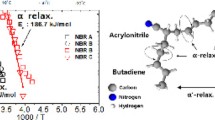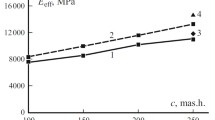Abstract
Pressure relaxation was examined in the cylinder of an MPT Monsanto processability tester after stopping the piston. The experimental function of the pressure drop F(t) was smoothed over and approximated by cubic splines. The spectra of pressure relaxation times (SPRT) were obtained according to the method of Schwarzl-Staverman. The SPRT method served well for estimating the spectra of the molecular-mass distribution (MMD) of polymers close in their physical sense to the SPRT. The correlation of the characteristic relaxation times and average molecular mass of ethylene-propylene rubbers and polyethylenes obtained by gel permeation chromatography was approximated by optimum models used for calculating the the molecular mass of rubbers according to the measurement results of the relaxation pressure of melts. The SPRT and characteristic relaxation times were used to analyze the significant technical properties of compositions based on polyethylene and rubber. The SPRT method was used to examine the failure of the cure network of butyl rubber and the dependence of the mechanical properties of thermoplastic elastomers on the molecular features of the decomposite.
Similar content being viewed by others
References
D. V. van Krevelen, Properties and Chemical Structure of Polymers [Russian translation], Khimiya, Moscow (1976).
V. P. Budtov, Physical Chemistry of Polymer Solutions [in Russian], Khimiya, St. Petersburg (1992).
C. D. Hahn, Rheology of the Processes of Polymer Processing [Russian translation], Khimiya, Moscow (1979).
E. Manefee, “Weight distribution from stress relaxation using modified Rouse theory,” Amer. Chem. Soc. Polym. Prepr.,21, No. 2, 55–56 (1980).
S. I. Wolfson, V. I. Kimelblat, and I. G. Chebotareva, “Application of spectra of pressure relaxation for the solution of practical problems of processing technology of polymers,” in: Abstracts, 18th Symp. Rheology [in Russian], Moscow (1996).
F. Schwarzl and A. G. Staverman, Physica,18 (1952).
V. I. Kimel'blat, “Study of the properties of polyurethane compositions based on simple and complex polyethers,” PhD Thesis, Kazan (1979).
V. I. Kimel'blat, S. I. Wolfson, E. N. Cherezova, N. A. Mukmeneva, and I. G. Chebotareva, “Comparative evaluation of the efficiency of stabilizers of ethylene-propylene rubbers under conditions of thermomechanical destruction”, in: 3d Russian Sci.-Pract. Conf. Materials for Rubber Industry [in Russian], Moscow (1996), pp. 79–83.
A. Tobol'skii, Properties and Structure of Polymers [Russian translation], Khimiya, Moscow (1964).
H. Wendel and J. Nooladi, “Generalized reptation model,” Macromolecules,15, No. 5, 1318 (1982).
G. V. Vinogradov and A. Ya. Malkin, Rheology of Polymers [in Russian], Khimiya, Moscow (1977).
Additional information
Kazan State Technological University, Tatarstan, Russia. Translated from Mekhanika Kompozitnykh Materialov, Vol. 34, No. 5, pp. 691–698, September–October, 1998.
Rights and permissions
About this article
Cite this article
Kimel'blat, V.I., Volfson, S.I., Chebotareva, I.G. et al. Estimation of the molecular characteristics of polymers by the SPRT method and study of their influence on the properties of compositions. Mech Compos Mater 34, 495–500 (1998). https://doi.org/10.1007/BF02254714
Received:
Issue Date:
DOI: https://doi.org/10.1007/BF02254714




